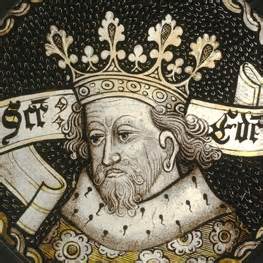Edward the Confessor
Edward the Confessor is known as a deeply pious English king whose death sparked a succession dispute that led to the Norman Conquest. Edward was born in 1003, when England was ruled by Saxons and invasions by Danes were commonplace. When the Danish king Canute had won enough battles and killed enough kings to set himself upon the English throne, Edward's mother, Emma, sent Edward and his brother Alfred away to Normandy, Emma's home. (Emma then married Canute.) Edward and Alfred grew up in Normandy and learned Norman ways of speaking and acting under the protection of Duke Robert. When Robert traveled to Italy for an extended period of time, he left Edward as a guardian of Robert's son William, who would presume on that relationship a bit later in the lives of both men. In England, meanwhile, Canute died in 1035 and was succeeded by his sons Harold Harefoot and then Hardacanute. Alfred and Edward had tried unsuccessfully to reclaim the throne for England, with Edward escaping back to Normandy but Alfred not being so lucky.
Invasions of England largely ceased during Edward's reign. However, internal strife was the norm, as Edward's preference for things Norman ran afoul of the Saxon nobles' preference for things Saxon. The most powerful Saxon noble, Earl Godwin, married his daughter to King Edward in 1045. A disagreement between Edward and Godwin resulted in the latter's exile in 1051. Just two years later, Godwin returned with an army, looking for a fight. No fight eventuated, however, because Godwin died soon after returning. His lands passed to a Norman inheritor named Ralph the Timid. Godwin's money and claims, however, passed to his son Harold. Harold ingratiated himself enough to both the nobles and to Edward in order to become the king's trusted adviser. Harold also helped his cause by laying waste to some Welsh lands in 1063. Edward the Confessor died in January 1066, leaving a land that was largely peaceful and prosperous. Edward's legacy includes the building of Westminster Abbey and the creation of the royal seal. What he didn't leave was a clear path of succession. William of Normandy, Harold Godwinson's onetime guardian, had visited Edward in 1051 and claimed that Edward had offered him the kingship at that time. Harold claimed that Edward whispered the kingship to him as he lay dying. The English nobles in charge of such things thought that Harold was the natural candidate, given his connections, his profile, and his military successes. But William had other ideas, as did Norway's Harald Hardrada, a distant descendant of Canute. The succession dispute resulted in both the Battle of Stamford Bridge and the Battle of Hastings. |
|
Social Studies for Kids
copyright 2002–2025
David White



 When Hardacanute died in 1042, the English noble elite recalled Edward, offering him the kingship. He accepted and was crowned on April 3, 1043, in Winchester Cathedral.
When Hardacanute died in 1042, the English noble elite recalled Edward, offering him the kingship. He accepted and was crowned on April 3, 1043, in Winchester Cathedral.
